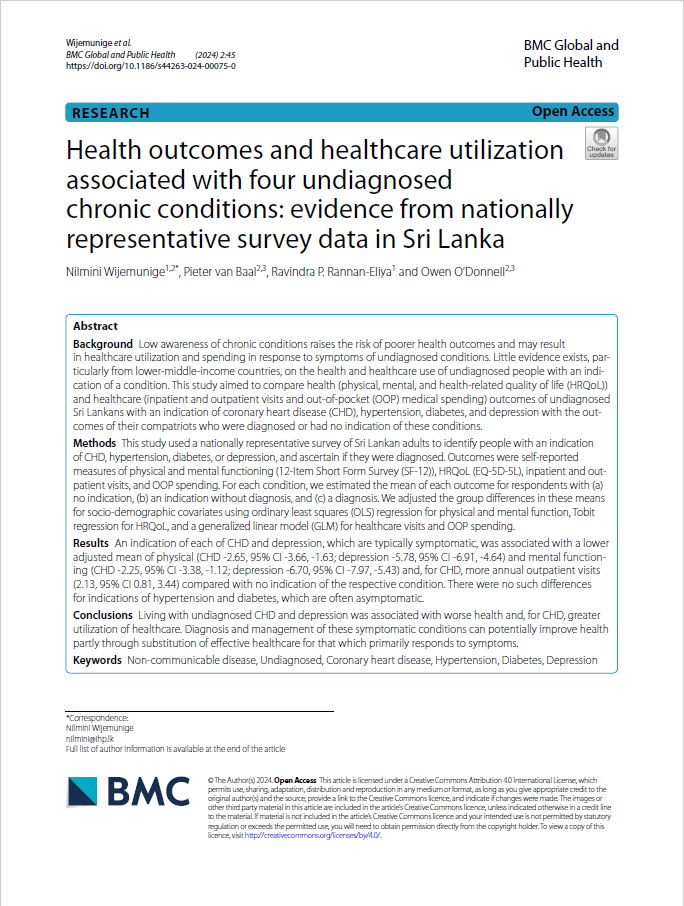Wijemunige, N., van Baal, P., Rannan-Eliya, R. P. & O'Donnell, O. (2024) Health outcomes and healthcare utilization associated with four undiagnosed chronic conditions: evidence from nationally representative survey data in Sri Lanka. BMC Global Public Health, 2(45). https://doi.org/10.1186/s44263-024-00075-0
This is published on BMC Public Health. Available under CC BY 4.0 License.
Abstract
Background
Low awareness of chronic conditions raises the risk of poorer health outcomes and may result in healthcare utilization and spending in response to symptoms of undiagnosed conditions. Little evidence exists, particularly from lower-middle-income countries, on the health and healthcare use of undiagnosed people with an indication of a condition. This study aimed to compare health (physical, mental, and health-related quality of life (HRQoL)) and healthcare (inpatient and outpatient visits and out-of-pocket (OOP) medical spending) outcomes of undiagnosed Sri Lankans with an indication of coronary heart disease (CHD), hypertension, diabetes, and depression with the outcomes of their compatriots who were diagnosed or had no indication of these conditions.
Methods
This study used a nationally representative survey of Sri Lankan adults to identify people with an indication of CHD, hypertension, diabetes, or depression, and ascertain if they were diagnosed. Outcomes were self-reported measures of physical and mental functioning (12-Item Short Form Survey (SF-12)), HRQoL (EQ-5D-5L), inpatient and outpatient visits, and OOP spending. For each condition, we estimated the mean of each outcome for respondents with (a) no indication, (b) an indication without diagnosis, and (c) a diagnosis. We adjusted the group differences in these means for socio-demographic covariates using ordinary least squares (OLS) regression for physical and mental function, Tobit regression for HRQoL, and a generalized linear model (GLM) for healthcare visits and OOP spending.
Results
An indication of each of CHD and depression, which are typically symptomatic, was associated with a lower adjusted mean of physical (CHD -2.65, 95% CI -3.66, -1.63; depression -5.78, 95% CI -6.91, -4.64) and mental functioning (CHD -2.25, 95% CI -3.38, -1.12; depression -6.70, 95% CI -7.97, -5.43) and, for CHD, more annual outpatient visits (2.13, 95% CI 0.81, 3.44) compared with no indication of the respective condition. There were no such differences for indications of hypertension and diabetes, which are often asymptomatic.
Conclusions
Living with undiagnosed CHD and depression was associated with worse health and, for CHD, greater utilization of healthcare. Diagnosis and management of these symptomatic conditions can potentially improve health partly through substitution of effective healthcare for that which primarily responds to symptoms.

